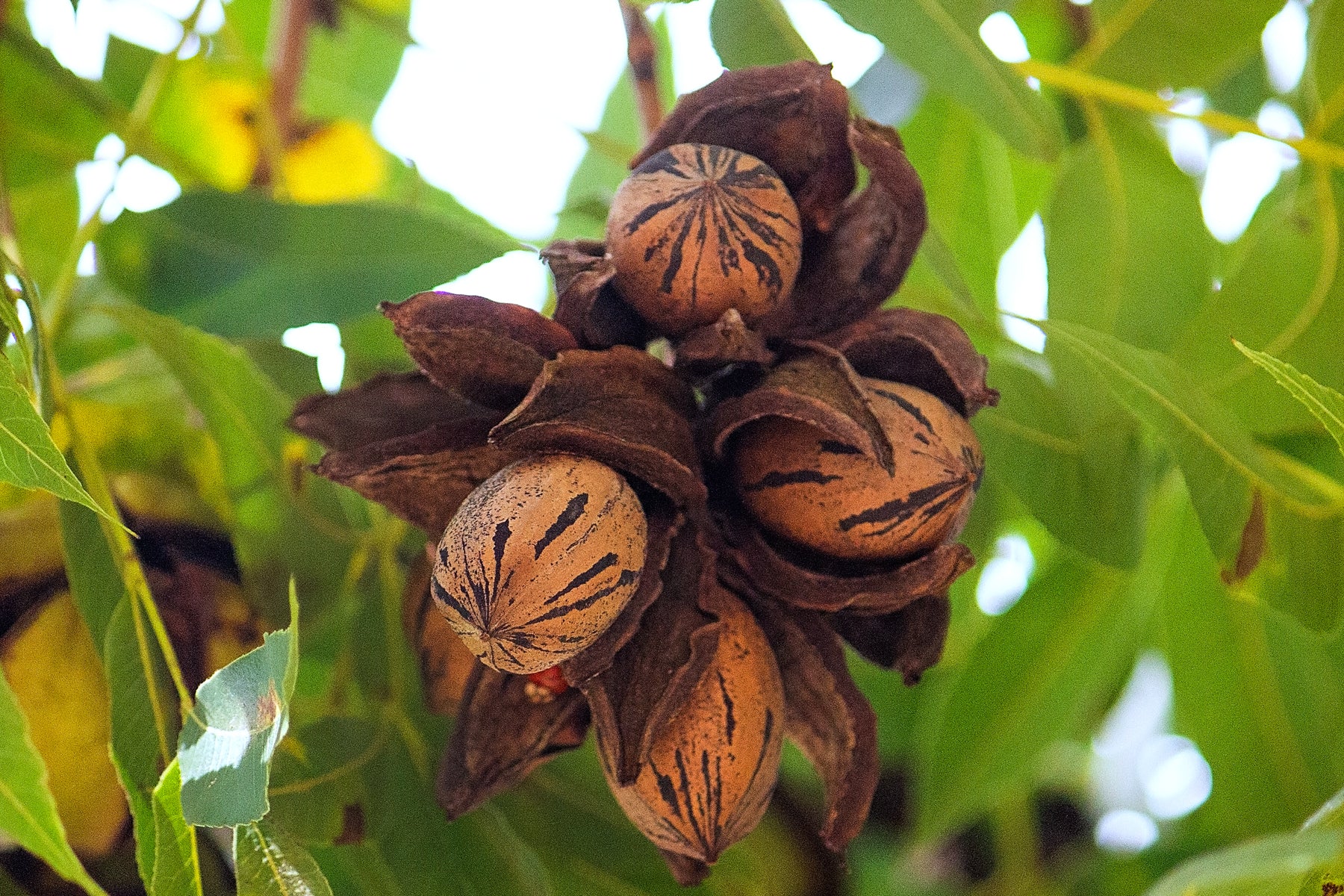From pecan pies to candied pecans and butter pecan chicken, these nuts are beloved for their rich and buttery flavor. They’re delicious in summer salads, sweet potato dishes for Thanksgiving, and turtle cookies any time of the year. And while purchasing pecans from the grocery store is convenient, there’s just something about getting fresh pecans from your own backyard. Yes, you can grow pecans at home (depending on the region you live in, of course). But how on earth do you take care of a pecan tree, and are they easy to care for? We have the answers to these questions and more in the article below.
To help you grow a healthy pecan tree and reap a successful harvest, we’ve put together a complete guide on how to plan and care for pecan trees.
Let’s dive in! Our first stop: defining pecan trees.
What Exactly Is a Pecan Tree?
First and foremost, let’s define these wonderful trees.
Pecan trees (scientifically carya illinoinensis), belong to the hickory family and are native to the Mississippi region of the United States. These trees thrive in southern locations and can grow to be quite large. Mature trees can reach 75-100 feet in height. That being said, if you are considering growing a pecan tree in your yard but your plot is on the smaller side, you may want to reconsider. There are no dwarf varieties of these large trees.
While it can take between five and ten years to start producing pecans, once the trees bear their first fruit, they continue to produce nuts for a very long time. Pecan trees can produce pecans for a hundred years or more! Just imagine all the pies, candy, and salads you can make with all those fresh pecans.
In addition to the pecans themselves, pecan trees are prized for their wood. As a relative to the hickory tree, when added to the smoking process, pecan wood gives smoked meats a sweet and smoky flavor. Wood from pecan trees is also choice for crafting furniture and hardwood flooring.
Now, let’s move on to preparing to plant your pecan tree.
Location, Location, Location
Just like in real estate, a key factor to consider before planting your pecan tree is its location. Pecan trees thrive in southern climates with long growing seasons. They also need a lot of room to grow, as they can reach excessive heights with an expansive canopy. Just think about all that glorious shade!
When planting a pecan tree, you will want to choose a spot that does not have any draining issues. Pecan trees have a long taproot which can become diseased or rot if the soil is continuously wet or soggy. For this reason, planting your pecan tree on a hilltop is ideal—and it also makes for a beautiful sight.
Tips for Planting Your Pecan Tree
Now that you’ve got the perfect location for your pecan tree, it’s time to plant one!
For best results, you will want to plant your pecan tree far away from other structures, such as your home or barn, and away from power lines. If you plan to plant more than one pecan tree, space them at least 60 but no more than 80 feet apart from each other. This ensures that each tree has enough room to grow and thrive.
As you prepare to plant your pecan tree, give extra love and care to the tree’s taproot. This root tends to circle up in the bottom of the container and needs to be straightened out before it’s planted. If you can’t straighten it out, cut off the lower part of the taproot.
If you have a bare root tree rather than a sapling in a container, soak it in water for several hours before planting it if the roots and tree feel dry and brittle.
Container or bare root alike, be sure to remove all damaged or broken roots before planting. When it comes time to plant, you will want to plant your pecan tree in a hole approximately three feet deep and two feet wide. You will also want to consider the time of year. It is best to plant container-grown trees in the spring or fall, while bare-root trees should be planted between December and March.
After planting, it will take a few years before your tree begins to produce pecans. So, if your tree doesn’t grow fruit in the first year or two (or three or four), don’t fret!
Tips for Growing a Pecan Tree
Next on our complete guide on how to plan and care for pecan trees are a few tips on how to successfully grow your tree. Like most things, pecan trees need regular care to survive (and thrive). To help your tree thrive, consider the following tips:
- Fertilize often. Your pecan tree will grow faster, stronger, and healthier when you fertilize the ground around the tree. For optimal results, sprinkle nitrogen-based fertilizer around the tree every few months during the growing season while the tree is still young. As it matures, apply both fertilizer and zinc sulfate, as zinc is a fabulous help for nut production. Try not to fertilize after June.
- Water regularly. While you water your flowers, don’t forget to also water your pecan tree! It’s especially important for young trees to receive adequate hydration. To do so, water your pecan tree once per week at least from early March through the end of September (in the absence of rain). You can help your tree retain moisture by applying mulch around its base.
- Protect from pests. Aphids are an enemy to pecan trees. You can get rid of them by spraying the leaves with a high-pressure hose spray. Or, you can release ladybugs into the area that will eat the aphids.
- Prune well. Pruning your tree will allow extra airflow, which will prevent disease. Pruning will also help your pecan tree to grow faster, stronger, and healthier.
If you wish to plant a pecan tree but don’t know where to start, check out Plant Me Green! Our online nursery allows you to buy pecan trees from the comfort of your own home.




Comments
I had planted my pecan tree in not so good area and over watered it. I thought it was dead. I pulled it up and chopped off the dry bark until I saw some yellowish on the bark. I measured it and it’s 10 inches from the root ball. I don’t know what to do with it. I read the above article and I do not have a hilly yard and most of the time it stays soggy after a rain. I have limited space in the front yard. I don’t even know if the root ball is damage or if it can come back. I want Mr. Peter Pecan to survive, so how can I save it?